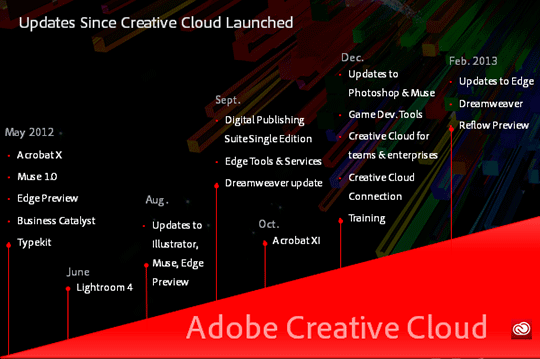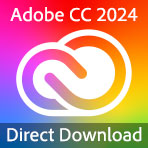Ever since it was announced seventeen months ago, Adobe made it clear that Creative Cloud was going to be a new way of purchasing their software, an avenue for anyone to use a complete collection of the most recent versions of all of their industry-leading creative tools with a set membership plan.
Last May the company rolled out the offering, and we’ve seen the Creative Cloud continuing to gain momentum – in fact, recently passing millions of members and signing up tens of thousands more every week… Meanwhile, the traditional option of buying a one-time Creative Suite license has remained for those customers who prefer that path.
Since the launch, Adobe has issued numerous free updates to Creative Suite programs (as is customary), as well as several rounds of entirely new CS product features that are only available to Creative Cloud members:
These additions have had the dual effect of making many Creative Cloud subscribers happy – while making some traditional CS6 license holders feel as if they’re missing out. On pages announcing new exclusive Cloud features, you might see comments such as:
“I am a longtime Adobe customer and have faithfully upgraded every suite since CS2. I love the tools and would like to have these newly available features – so why are they exclusive only to Creative Cloud subscribers? It seems like a disappointing way to reward loyal customers like me.”
And the response typically goes along these lines:
“Adobe said when they announced Creative Suite 6 and Creative Cloud that they were offering two models: the previous licensing model and a new monthly membership model. Each option has its advantages, pros and cons. If you go with the standard licensing, you get a static version with a high upfront cost and a license to use it indefinitely. If you go with the Creative Cloud instead, then for an affordable monthly price you get complete use of a comprehensive and ever-evolving package – and get new features as soon as they are ready at no additional charge, instead of having to wait until the next official release.”
That makes sense in some ways, but in our opinion here is a case where the company hasn’t been as clear as possible in explaining what’s behind that – in other words, why Cloud customers can receive continual feature upgrades where fixed CS licensees can’t. And it actually has to do with the U.S. accounting rules (GAAP) for revenue recognition in the software industry.
Why Accounting?
Adobe has a 30-year history of releasing discrete software products, where each version is completely delivered to the customer and recognized on their books at the time of purchase. Any future free updates to existing programs are limited to maintenance: bug fixes, compatibility changes, support of new hardware, and security patches. Future upgrades are separate and optional. That’s the precedent, and it’s always been done this way so that the accounting is clean and customer transactions are complete in and of themselves.
Per AICPA SOP 97-2, if the company were to try adding major features with additional value to a formal release after the fact, then they would not be able to recognize the purchase when it was made, and it would be unworkable from an accounting perspective with multiple simultaneous versions going on and trying to proportionally recognize revenue over a variable period based on undetermined future functionality for each separate deliverable.
It was not widely disseminated, but Adobe CEO Shantanu Narayen stated as much in a 2011 conference call with financial analysts:
“In terms of moving forward and in future releases of CS, and with everything that’s changing in the Creative environment, we believe that [offering subscriptions] really allows us to have more innovation. Take a product like Edge. If you have a product like Edge that’s on subscription, that’s offered to all of the subscription customers, that provides the ability for people to stay current. And today, with the 18-month cycles, you aren’t allowed to do that, as you know, given financial accounting. So that’s the strategic rationale for continuing to drive towards subscriptions and attracting new customers to the platform.”
Other Adobe voices have confirmed this, although again it has not been widely publicized. The Sarbanes-Oxley regulations enacted a decade ago have also been cited: “It has to do with accounting practices and isn’t unique to Adobe,” and “It is US legislation which prohibits adding features for free on perpetual licenses,” and “Having worked at Adobe, I can confirm this.”
Bryan Lamkin, Adobe Senior Vice President, writes in a new blog post:
“As a former product manager, I remember the team’s frustration when they were forced to hold back features to fit our 18-month Creative Suite product cycle. It was very difficult to deliver new innovations “off-cycle” due to our delivery and accounting model. (Every desktop software company struggles with this same challenge.) Nothing is more satisfying to one of our talented engineers than getting a new product feature into the hands of customers quickly, and now we can. But Creative Cloud is so much more than a mechanism for getting new product features in the hands of customers faster…”
And Al Mooney, Premiere Pro Product Manager, adds:
“Historically, Adobe has run on a 12-18 month release cycle, and licenses were perpetual. This meant that, were we to (for example) release a new product in May, if we were to hear from the community in June that there was an absolutely critical feature that we were lacking, the earliest we could provide customers with that feature would be the following May. This is not an internal Adobe thing, it’s due to very limiting and strict revenue recognition laws which prevent the addition of new features to perpetual license customers at zero cost.
The Creative Cloud model changes all this. Because it’s a subscription system, we are going to be able to add new features to the software much more regularly than the 12-18 month release cycle, and I predict you’ll start seeing this change pretty soon. This, I believe, provides significant added value to Creative Cloud when compared to the previous model. Creative Cloud allows us to much more aggressively develop, and in these days of light-speed technological change, this will, I hope, be a great benefit.”
The Release Schedule Quickens
In the spring of 2011, in an effort to address the explosion of mobile devices and accelerating pace of technological changes and platforms, Adobe resolved to make more frequent upgrades to the Creative Suite software. They issued a mid-cycle version – Creative Suite 5.5 – and changed their official release cycle to once per year, so that customers would have the opportunity to use newer versions on a more frequent basis to catch up with technology.
And now fast forward to the current day, Creative Cloud takes it a step further. As Adobe’s growing large-scale membership-based software offering, the deal is a comparatively low price per month for the ability to use the latest-and-greatest versions of almost everything. No matter which plan is chosen, billing is steady and recognized on a monthly basis so there is no issue with the accounting – the customer simply receives complete access so long as payments are current. This means Adobe can make and deliver upgrades to what’s available in the Cloud on a frequent (even monthly) basis, and they have already done this – adding Lightroom, Acrobat XI, Behance ProSite, Digital Publishing Suite, Muse and Edge to the mix while issuing Cloud-only upgrades to Illustrator, Dreamweaver, and Photoshop.
Still, a fuller explanation might have been helpful in understanding where Adobe was coming with this new delivery model. But whatever came across, the bottom line is there became two ways to purchase the best software – the traditional perpetual route which remains, and now the new more dynamic Cloud approach which opens access to a greater variety of more up-to-date tools (ongoing innovation) at a fixed monthly rate. Which you choose is up to you, but at least now you know a bit more on the background on how it happened this way.
See Also
- The 10 most common myths about Creative Cloud
- What are the differences between Adobe CC vs. CS6?
- Download free Adobe books (choose over 30 titles)
- Free! Watch 200+ new courses from Adobe MAX
- How to save 60% with the Adobe education editions
- Free Adobe Stock! Download 1,000,000+ top images
Do you have any questions about CS6 or the Creative Cloud? Check out our extensive Creative Cloud FAQ, or just ask them below and we’ll get you answers fast!
Keep up with the latest on Adobe software — follow us on Facebook or Twitter, or subscribe to our RSS feed… You can also enter your email and have new articles sent directly to your Inbox. We are reader-supported; when you buy through links on our site, we may earn an affiliate commission.








It would have been nice if they had been clearer about it from the start. Faithful customers have been getting a wrong message.
Thank you for explaining this in a way that Adobe hasn’t!
Well, this is helpful, but honestly I don’t mind it too much. The way I look at it is the Cloud folks are doing the beta testing for me now with these new features… then I’ll get the chance to decide if I want to pay for them myself next year. :)
I also have a colleague who is currently a subscriber. He is happy too with how it’s working out for him with the cloud, so maybe it’s a win-win.
My explanation is much more straightforward: Adobe is mainly interested in our money! A subscription on this ‘cloud’ thing costs a lot more (euro’s) than upgrading to a newer version of a normal license in the 18 month cycle; no wonder they need to keep those cloud customers ‘happy’. And remember that one now has to upgrade every time to be eligible for an upgrade of a traditional license, no more skipping an upgrade and still be eligible like before this new ‘policy’. To further improve earnings it was a logical next step to reduce the cycle from 18 to 12 months.
Hi Dick, how does it cost more? We have clients here who used to pay US$2,600 for a one-time copy of the Master Collection… Now instead they pay $50/month and get even more tools (about $10,000 in value for the different products included in Creative Cloud), plus the upgrades are free so they will always be able to use the latest-and-greatest versions of those tools for the same price.
If you do the math, the breakeven on $50/month vs. $2,600 comes out to 52 months – meaning if you’re planning to use the software for up to four years, then you are far better off going with the Cloud. The figures are different in other currencies, but the math should be similar.
Adobe is actually making much less from these cloud sales than normal. In fact, their reported earnings the past two quarters were short of analyst estimates. What they are hoping here is that Cloud customers find good value in the offering that they want to keep subscribing. But in any event, the Creative Cloud is option and not a requirement, and you can buy/upgrade your tools the traditional perpetual way if you prefer.
When looking at just Photoshop CS6 the math I worked out is like this. An upgrade to Photoshop CS6 costs €277.09. Photoshop in ‘the cloud’ will cost €24.95 per month, that equates to €299.40 per year, €449.10 for 18 months and 598.80 for two years. (This is of course assuming Adobe does not change their subscription rates after your initial contract expires…)
Well sure, if you would only use one single tool then it works out better to not pay for over 20 of them in the Creative Cloud – so in your case, just get the one you want instead… And that won’t cost more either, since Adobe has not increased prices on the traditional licenses.
Also, it’s different for those customers coming in from scratch compared to those owning previous products, because of the availability of upgrade pricing. In other words, the calculation on whether the Creative Cloud is better versus traditional licensing changes if you already have a significant investment made into a recent perpetual version of the software. For more on this, see:
Creative Cloud vs. Creative Suite 6 – Which Is Right for You?
Thanks very much for this explanation. I wasn’t upset in the first place—unlike many others, it seems :) — but this increased my understanding of the “reasons why.”
Actually, it seems to me that Adobe has omitted a very obvious step from this change-over: the ability to subscribe to Creative Cloud at a much lower rate and ONLY have access to the Cloud-only apps. In other words — a way for the permanent-license purchasing customers to carry on with their permanent licenses, and ALSO pay a very much smaller monthly fee to get that extra functionality they need in the Cloud (Edge and Muse, specifically). Or have they in fact made that possible and I just haven’t heard about it?
Speaking of which, I do seem to recall reading somewhere on this site that it’s possible to just get the one tool you need in the Cloud for a lower rate. I recall Photoshop, definitely, being mentioned, and I don’t know what other products that applied to, if any. However, I couldn’t find this plan on Adobe’s site. IS that possible? If I, for instance, just want InDesign (not the whole Creative Cloud), can I pay a lower monthly rate to get just access to that one app?
If so, is that possible for ANY Adobe product — to just get access to the one instead of Creative Cloud — or just a couple? Is it possible for Muse or Edge? Is there a list somewhere, with rates?
Thanks for all your work to clarify and communicate Adobe’s policies and products.
Thanks Mike, those are really good points and questions actually, appreciate that. Here are some answers for you:
First off, anyone at all (traditional owner or not) can sign up for a completely free (for life) level of membership to the Creative Cloud – which includes some of those tools and services you mention (actually about 10 in all) – see this article for more details (and how to get it):
How to Join Adobe’s Creative Cloud for Free
AND, included in those free Cloud tools is in fact, Adobe Edge 1.0 – the full permanent and perpetual license – get it now while it lasts:
Download FREE Adobe Edge Animate 1.0 + 500 Free Web Fonts
As to your other questions, about single product subscriptions. Yes, this is in fact very possible – for any of those Adobe programs, including Photoshop, InDesign, Muse, etc. – the offer is called Single-App Membership, and it typically runs $19/month for a subscription to the latest version, with all upgrades included… Here is the complete price list for all tools as well as more details:
Creative Suite Subscription Editions Now Available
Thanks again for your feedback Mike, and hope this helps! Feel free to post back if you have any further questions.
Well, if these guys want me to upgrade every two years, then they better make sure there are some DAMN GOOD new features. I’m talking to you, Flash.
I was just checking the reviews for Creative Cloud, I wanted to see what people thought of it compared to CS6. I found this page on Adobe’s site and it seemed pretty glowing:
http://www.adobe.com/products/creativecloud/reviews.html
What has your experience been? Is that accurate?
Welcome Arthur, thanks for your comments. We use Creative Cloud every day of course and love it, wouldn’t want to go back… We’ve seen the page you posted with all the CC reviews (all from real customers BTW) and guess they are feeling the same way – almost 5 stars out of 5!
If you’re looking for more information on making a decision between getting the Creative Cloud over CS6 traditional, check out our guide:
Adobe CS6 vs. Creative Cloud: Which Should You Get?
Hope this helps! Just post back if you have any additional questions.
What guarantee do we have that Adobe is not going to raise the cost of the monthly payments for Creative Cloud? They may say they are not going to, but they can if they want to.
It may sound like it cost less with promotions etc, but it can actually cost more if you don’t use all the products or if Adobe raises the prices later – which they will in the future [even if Adobe says is not going to] if they get enough people to sign up for the cloud.
It’s simple, Adobe wants to make the cloud monthly payments attractive now so that they can do whatever they want later. Adobe wants everyone to go on the cloud. This will make them more money down the road.
Thanks for sharing your thoughts Willie, but you actually have the equation backwards… See Myth #6 here:
The 10 Most Common Myths About Adobe’s Creative Cloud
I had some of the same concerns at the outset, because these facts were not clearly delineated. I have now been on “The Cloud” for 10 months and I would not go back to the old model of software. I have had nothing but joy, delight and rock -n- roll with this model of software delivery. And we ain’t beta testing, we are getting software already beta tested, and if a bug comes up, it gets squashed.
This is the way it should be :)
P.S. the cost model saves me money over the 18-month traditional model.
A very satisfied customer
That’s really great to hear Kevin, and thanks for weighing in.
Generally, the Creative Cloud has been getting near-5-star reviews from customers, so it sounds like your experience is not unusual.
Currently have CS5.1. It was recently corrupted and I am having difficulties restoring it’s essential daily operation/utility on my newly installed Mountain Lion OSX system, partially because there was a recommendation from Adobe help site to uninstall and then re-install it.
As I understand it, a subscription to CC for the reduced cost @ $19, will enable the download of the latest Photoshop release, as well as LightRoom which is also a part of my installation… Will I also have the opportunity to use Illustrator…or that require the purchase of Illustrator license?
Also will it be possible to use these apps on Windows 7 unit that meets app spec requirements?
Hey Bob, yes – with Creative Cloud you get everything: all the new CC applications including Photoshop and Illustrator, plus Lightroom, InDesign, Premiere, Muse, Acrobat Pro, online storage, web hosting, and many more.
See what all subscribers get contained in Creative Cloud.
If you want, you can join the Cloud for free to get 30-day full access to these new tools, and then decide if you want to purchase after that.
We also have the CC direct links if you just want to quickly download & try any one or two of the products.
Finally, yes – Adobe CC should definitely support your Windows 7 platform… per the complete minimum system requirements.
I also have used CS6 and Lr for a number of years – and could not live without it. HOWEVER, considering the strategic change to Cloud:
What happens if ADOBE were involved in mergers, bankruptcies, changes of ownership or strategies, is “run over by a bus”? Or, simply brought down, either accidentally or malicious intruders, for a period of time longer than the 90 days confirmation time?
CC subscribers would be left hanging – since there exists no assured way of securing the actual the software for a user, independent from what may or may not happen on the ADOBE master side.
There is no reason to question ADOBE’s integrity, however, our general economic reality of late has been “Que sera, Que sera,” as the song goes.
I would appreciate it if ADOBE would comment, please.
Well Dietrich, if something like that were to happen to the Internet, then our guess is we’d have much bigger problems on hand than to worry about how our Photoshop ran…
But if it helps, Adobe will be extending the revalidation period to up to 180 days, or six full months that all the CC tools can run on your desktop without any disturbance or online connection.
Thanks for your reply.
However, that does not address my question, namely, what happens if ADOBE, beyond its control, is unable to deliver CC even after 180 days? I can run CS6 and Lr5 at any time from my DVDs completely offline, unconnected and independent from the Internet. CC would not allow me to do this. Has ADOBE provided for any contingency plan for such case at all?
No, we haven’t heard of one – but if the Internet being down for 180 days straight keeps you up at night, then sorry there’s nothing we can say here to help you…
We will say that this type of fear is not shared by most people, as we just heard today that 30 million customers have already signed up for Creative Cloud.
Obviously, you are not addressing my question. I do not worry about the Internet being down. And certainly, that idea does not keep me up all night. Please read the question. The question I am raising has nothing to do with the Internet. It has to do with ADOBE and situations where / if ADOBE should be unable to continue supporting CC.
For good reasons are the US DND’s, etc. switching to LINUX, so as to control software and systems they depend on – regardless and independent from the worldwide net. Similarly, as it stands, a user has not control over the applications if ADOBE were unable, for some reasons whatever, to support CC.
I would really appreciate it, if I would be able to receive a concise reply to a straight question, as opposed to navigating round it without any relevance. Thank you.
We did read the question. Your precise question was, “what happens if ADOBE, beyond its control, is unable to deliver CC even after 180 days?”
So clearly you seem to be worried about some infrastructure not being able to provide any service or revalidate CC for six full months. Sorry, but such a thing has never happened to a major company in the history of computing, and is extremely unlikely to ever happen – so honestly it’s not really worth our time entertaining idle, trolling questions such as this one.
For anything else, please refer back to the “myths” link in our first response – thanks.
@ProDesignTools
How is “what happens if Adobe goes out of business?” a “trolling question”? No “major company in the history of computing” has ever gone out of business? NeXT, Sun, Claris, Macromedia, and other significant software companies have disappeared, sometimes with someone else taking over support for their software, sometimes without. And many, many smaller companies have disappeared and left customers holding the bag when it comes to software support, or even rendered software useless because it needed to talk to servers. Is Adobe /likely/ to go out of business any time soon? No, Is it /possible/? Yes. If they were still releasing perpetual-license products, we’d at least be able to use whatever the last version was until an OS update broke it.
This is by far the most successful and widely-adopted creative software in the world, ever… Sorry, there are a lot of things in the world we worry about, but the notion of Adobe going out of business with no future for Photoshop is not one we lose sleep over.